
The Advanced Gas-cooled Reactor (AGR) is a type of nuclear reactor designed and operated in the United Kingdom. These are the second generation of British gas-cooled reactors, using graphite as the neutron moderator and carbon dioxide as coolant. They have been the backbone of the UK's nuclear power generation fleet since the 1980s.

Torness nuclear power station is a nuclear power station located approximately 30 miles (50 km) east of Edinburgh at Torness Point near Dunbar in East Lothian, Scotland. It was the last of the United Kingdom's second generation nuclear power plants to be commissioned. Construction of this facility began in 1980 for the then South of Scotland Electricity Board (SSEB) and it was commissioned in 1988. It is a local landmark, highly visible from the A1 trunk road and East Coast Main Line railway.
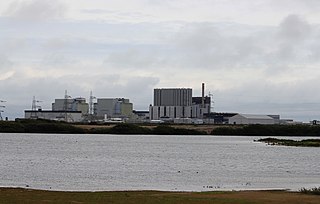
The Dungeness nuclear power stations are a pair of non-operational nuclear power stations located on the Dungeness headland in the south of Kent, England.

Dounreay is a small settlement and the site of two large nuclear establishments on the north coast of Caithness in the Highland area of Scotland. It is on the A836 road nine miles west of Thurso.
British Energy was the UK's largest electricity generation company by volume, before being taken over by Électricité de France (EDF) in 2009. British Energy operated eight former UK state-owned nuclear power stations and one coal-fired power station.
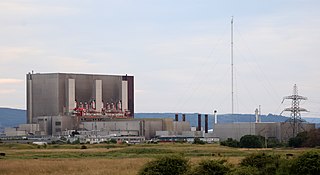
Hartlepool nuclear power station is a nuclear power station situated on the northern bank of the mouth of the River Tees, 2.5 mi south of Hartlepool in County Durham, North East England. The station has a net electrical output of 1,185 megawatts, which is 2% of Great Britain's peak electricity demand of 60 GW. Electricity is produced through the use of two advanced gas-cooled reactors (AGR). Hartlepool was only the third nuclear power station in the United Kingdom to use AGR technology. It was also the first nuclear power station to be built close to a major urban area.
The Nuclear Liabilities Fund is a fund of the UK Government to provide arrangements for funding certain long-term costs for the decommissioning of eight nuclear power stations formerly owned by British Energy, now EDF Energy. Responsibility for the fund within government lies with the Shareholder Executive, on behalf of the Department for Business, Energy and Industrial Strategy.
Nuclear power in the United Kingdom generated 16.1% of the country's electricity in 2020. As of August 2022, the UK has 9 operational nuclear reactors at five locations, producing 5.9 GWe. It also has nuclear reprocessing plants at Sellafield and the Tails Management Facility (TMF) operated by Urenco in Capenhurst.

EDF Energy is a British integrated energy company, wholly owned by the French state-owned EDF, with operations spanning electricity generation and the sale of natural gas and electricity to homes and businesses throughout the United Kingdom. It employs 11,717 people, and handles 5.22 million business and residential customer accounts.

Heysham nuclear power station is operated by EDF Energy in Heysham, Lancashire, England. The site is divided into two separately-managed nuclear power stations, Heysham 1 and Heysham 2, both with two reactors of the advanced gas-cooled reactor (AGR) type.
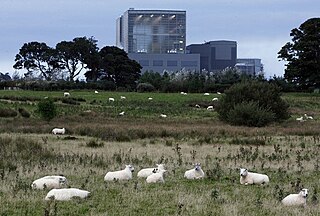
Hunterston B nuclear power station is a shut-down AGR nuclear power station in North Ayrshire, Scotland. Located about six miles south of Largs and about 2+1⁄2 miles northwest of West Kilbride on the Firth of Clyde coast. It is currently operated by EDF Energy, and began producing electricity in 1976.

Energy in the United Kingdom came mostly from fossil fuels in 2021. Total energy consumption in the United Kingdom was 142.0 million tonnes of oil equivalent in 2019. In 2014, the UK had an energy consumption per capita of 2.78 tonnes of oil equivalent compared to a world average of 1.92 tonnes of oil equivalent. Demand for electricity in 2014 was 34.42 GW on average coming from a total electricity generation of 335.0 TWh.

Scottish Nuclear was formed as a precursor to the privatisation of the electricity supply industry in Scotland on 1 April 1990. A purpose-built headquarters was built in 1992 in the new town of East Kilbride.
Nuclear Electric was a nuclear power generation company in the United Kingdom. It was formed in 1990 as part of the privatisation process of the UK Electricity Supply Industry.
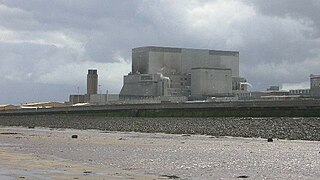
Hinkley Point B nuclear power station was a nuclear power station near Bridgwater, Somerset, on the Bristol Channel coast of south west England. It was the first commercial Advanced Gas Cooled reactor to generate power to the National Grid in 1976 and shares its design with sister station Hunterston B nuclear power station. It ceased operations permanently on 1 August 2022.
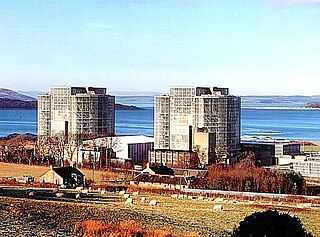
Hunterston A nuclear power station is a former Magnox nuclear power station located at Hunterston in Ayrshire, Scotland, adjacent to Hunterston B. The ongoing decommissioning process is being managed by Nuclear Decommissioning Authority (NDA) subsidiary Magnox Ltd.

Magnox Ltd, currently trading as Nuclear Restoration Services, is a wholly-owned subsidiary of the Nuclear Decommissioning Authority (NDA), responsible for the safe decommissioning of British nuclear sites. Originally created for the management of Magnox nuclear reactors, it went through various forms of organisation throughout privatisation of the nuclear industry, until coming into NDA ownership in 2019. It rebranded to NRS in October 2023.
Sir James Hann was a British businessman and former chairman of Scottish Nuclear.
This is a list of all the commercial nuclear reactors in the European Union and in Europe, with operational status. The list only includes civilian nuclear power reactors used to generate electricity for a power grid. All commercial nuclear reactors use nuclear fission. As of May 2021, there are 180 operable power reactors in Europe, with a combined electrical capacity of 159.36 GW. There are currently 8 power reactors under construction in Europe.

Vulcan Naval Reactor Test Establishment (NRTE), formerly HMS Vulcan, is a UK Ministry of Defence (MoD) establishment in Scotland, operated by Rolls-Royce Submarines.














